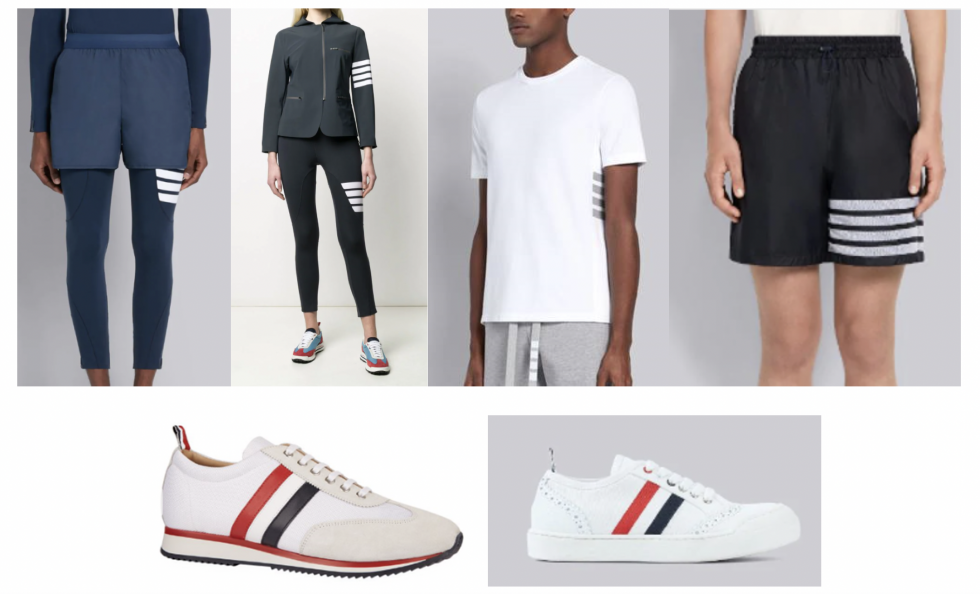Thom Browne and adidas have been in court this week, with the start of a trademark trial pitting adidas’ 3 stripes against a 4-stripe motif that TB has been using for 15 years. Thus far, the parties’ arguments have largely mirrored what they have been claiming all along, with adidas asserting that TB’s apparel – which is increasingly coming in the form of sportswear items, and not just tailored high fashion garments – features a 4-stripe logo that not only looks like its own mark but is depicted “in a manner that is confusingly similar to [its] three-stripe mark.”
All along, adidas has taken issue with: TB’s alleged effort to “encroach into direct competition” with it by offering up an expanding collection of striped “sportswear and athletic-styled footwear” and a roster of big-name partnerships with sportswear teams. (We pondered back in 2019 whether a tie-up between TB and FC Barcelona would turn the parties’ TM opposition battles into fully-fledged litigation.) Since its founding in 2003, TB has been primarily known for “its tailored and cropped men’s suits and jackets and avant-garde womenswear.”

Thom Browne’s defenses focus on: (1) the differences between the two parties’ positioning in the market (high fashion vs. mass-market sportswear) and corresponding pricing, and the resulting lack of consumer confusion; (2) adidas’ alleged failure to take action sooner (TB has argued that for more than 10 years, adidas made no complaints about its use of the 4-stripes; “They fell asleep at the wheel and woke up too late,” Browne’s attorney told the jury early this week); and (3) adidas’ 3-stripe mark is aesthetically functional, among other things.
– On the survey front: adidas’ expert Hal Poret testified to a survey that he conducted involving 2,400 people, half of whom were presented with 8 different images of Thom Browne garments – and a pair of TB footwear – bearing the 4-stripes motif, while the other half saw the same images but without all of the stripes. And in an attempt to focus on post-sale confusion, none of the images included Thom Browne word marks.
– The result: 26.9% of the individuals revealed that they thought the products came from adidas, with no shortage pointing to the stripes as the reason for making the connection as to source.
– Counsel for TB pushed back, arguing that had other TB marks been present in the images, there would be less room for confusion.
– TB previously argued that it has not witnessed any examples of actual confusion since it switched from 3 stripes to 4 stripes in 2007.
In non-adidas litigation updates …
Patagonia v. Gap – Gap filed a motion to dismiss the case waged against it by Patagonia, which is accusing it of TM infringement due to its sale of fleece jackets that mirror Patagonia’s Snap-T fleece. Gap argues that “the Complaint contains no allegation that [it] used PATAGONIA or any similar designation in manner whatsoever and the mark that the allegedly infringing products is sold under, GAP, is dissimilar as a matter of law.”
MetaBirkins – ICYMI: On the heels of SDNY Judge Rakoff rejecting both Hermès’s and Mason Rothschild’s motions for summary judgment, the parties are slated for a Jan. 30 trial.
Chanel v. WGACA – Trial is approaching – albeit not as quickly – for Chanel and What Goes Around Comes Around, who have been facing off since Chanel filed a TM suit against the reseller in 2018. This week, SDNY Judge Stanton called on the parties to provide him with a status update & a proposed order scheduling the exchange of pre-trial materials by Jan. 19.
Some Quick Hits
– $$$ – Luxury brands are expected to keep raising prices this year. Rolex setting the tone by upping price tags in the U.S. & UK by an average of 2.5%. Meanwhile, Hermès revealed in a Q3 earnings call last fall that it will raise prices notably this year. More to come on this very soon.
– LUXURY IN CHINA – Duty-free haven Hainan continues to draw in Chinese consumers. In 2021, Hainan accounted for 13% of China’s domestic luxury spend vs. 6% in 2019, per Reuters. Also note: By 2025, brands will be able to operate their own duty-free stores there, rather than partnering with local players.
– WEB3 – Prada Group’s Marketing Director & CSR Head (and future CEO) Lorenzo Bertelli saysthat “one of the biggest challenges & opportunities of the last 2 years is how to be effectively present in the web3,” noting that Prada is “creatively and strategically approaching web3 while some of our competitors are rushing to be there.”
– BRAND MASHUPS are not ceasing in 2023 – Tiffany & Co. and Fendi offered up their collaborative Baguettes for 24 hours this week. Comments on social media quickly revealed that the offerings swiftly sold out, which might suggest that consumers are not tired of such comminglings of marks.
And in a bit of deal-making news this week … Frasers cut down its stake in Hugo Boss, revealing that it now holds 3.9% of Hugo Boss stock directly and 25% via the sale of derivatives, bringing its “maximum exposure” to the German fashion brand to $691 million. Meanwhile, DBGI – which boasts a curated collection of “luxury lifestyle, digital-first brands” – completed its acquisition of Sundry, which is now a wholly owned subsidiary of DBGI.